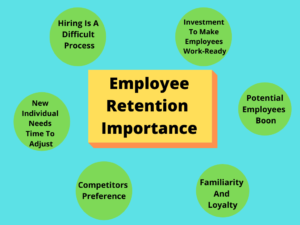One of the most critical challenges that organizations face today is to retain their talented employees. The success of any organization largely depends on its human resources, and the loss of talented employees can have a significant impact on its growth and profitability. Therefore, developing a talent retention strategy is vital for organizations to ensure that they retain their best employees and maintain a competitive advantage. This article will delve into the topic of talent retention. It is from discussing the importance of talent retention and some strategies that organizations can adopt.
Contents
- 1 Importance of Talent Retention in Organizations
- 2 Key Strategies for Developing a Talent Retention Strategy
- 3 Creating a Positive Work Environment to Retain Top Talent
- 4 Implementing a Talent Retention Strategy: Best Practices and Case Studies
- 5 Future of Talent Retention: Future and Innovations
- 6 Conclusion
Importance of Talent Retention in Organizations

Talent retention is critical for organizations that want to maintain a competitive advantage and achieve long-term success. Here are some reasons why talent retention is so important:
- Cost Savings: Retaining top talent is more cost-effective than recruiting and training new employees. The recruitment and training process can be time-consuming and expensive. The organization may not be able to replace the lost talent with someone equally competent.
- Maintaining Organizational Performance: Talented employees possess the skills, knowledge, and experience necessary to help the organization succeed. Losing talented employees can have a significant impact on organizational performance. It is affecting productivity, revenue, and customer satisfaction.
- Enhancing Employee Engagement: Retaining talented employees can help to enhance employee engagement, leading to increased productivity, job satisfaction, and overall organizational performance. When employees feel valued and appreciated, they are more likely to be engaged and committed to their work.
- Maintaining a Competitive Advantage: An organization’s competitive advantage largely depends on its human resources. Retaining talented employees can help to maintain this advantage, as they possess the skills, knowledge, and experience necessary to help the organization succeed.
- Promoting a Positive Work Culture: Retaining top talent can promote a positive work culture, as talented employees serve as role models for other employees. When employees see that the organization values and rewards talent, they are more likely to be motivated to perform at their best.
Key Strategies for Developing a Talent Retention Strategy
Developing a talent retention strategy is critical for organizations that want to retain their best employees and maintain a competitive advantage. Here are some key strategies for developing a talent retention strategy:
- Conduct a Talent Audit: Organizations should conduct a talent audit to identify their top performers and critical roles. This will help them to understand the talent they have and the talent they need to retain.
- Identify Factors that Drive Retention: Organizations should identify the factors that drive retention for their employees. This can be done through employee surveys, focus groups, and exit interviews. Understanding the factors that drive retention can help organizations to develop a talent retention strategy that meets the needs of their employees.
- Develop a Compensation and Benefits Strategy: Offering competitive compensation and benefits is essential for retaining talented employees. Organizations should ensure that their compensation and benefits packages are competitive with other organizations in the industry.
- Provide Opportunities for Growth and Development: Talented employees are more likely to stay with an organization if they feel that they have opportunities for growth and development. Organizations should provide employees with training and development opportunities, mentorship programs, and leadership development programs.
- Create a Positive Work Environment: Employees are more likely to stay with an organization if they feel that the work environment is positive and supportive. Creating a positive work environment involves ensuring that employees feel valued. It also has access to the necessary resources and is provided with opportunities for growth and development.
- Recognize and Reward Employee Achievements: Recognizing and rewarding employee achievements is an essential part of retaining talented employees. Organizations should have a system in place for recognizing and rewarding employee achievements, such as bonuses, promotions, and public recognition.
- Foster a Culture of Collaboration and Teamwork: Fostering a culture of collaboration and teamwork is essential for retaining talented employees. Organizations should encourage employees to work together, communicate openly, and share their knowledge and expertise.
- Develop a Succession Plan: Developing a succession plan is critical for organizations that want to retain top talent. A succession plan ensures that the organization has a pipeline of talented employees ready to take on critical roles when vacancies arise.
Creating a Positive Work Environment to Retain Top Talent

Creating a positive work environment is crucial for retaining top talent. Here are some key factors that contribute to creating a positive work environment:
- Communication: Effective communication is essential for creating a positive work environment. Employees need to be informed about organizational goals, expectations, and changes. Managers should encourage open communication, listen to employee feedback, and provide regular feedback to employees.
- Fairness and Transparency: Employees value fairness and transparency in their workplace. Organizations should ensure that policies and procedures are clear and applied consistently. Managers should be transparent about decisions that affect employees and provide explanations when needed.
- Work-Life Balance: Maintaining a work-life balance is critical for employee well-being and job satisfaction. Organizations should offer flexible working arrangements. These are such as telecommuting and flexible schedules, to help employees balance their work and personal responsibilities.
- Professional Development: Providing opportunities for professional development is essential for creating a positive work environment. Employees want to feel that they are growing and developing in their careers. Organizations should provide training and development opportunities, mentorship programs, and leadership development programs to help employees achieve their career goals.
Implementing a Talent Retention Strategy: Best Practices and Case Studies
Implementing a talent retention strategy requires careful planning, execution, and evaluation. Here are some best practices and case studies for implementing a talent retention strategy:
Best Practices
- Involve Employees in the Process: Employees are the key stakeholders in any talent retention strategy. Involving them in the process can increase their buy-in and commitment. Organizations should seek employee feedback, input, and suggestions throughout the process.
- Customize the Strategy: There is no one-size-fits-all talent retention strategy. Organizations should customize their strategies based on their unique culture, values, and goals. They should also tailor their strategies to meet the needs and preferences of their employees.
- Monitor and Evaluate the Strategy: Monitoring and evaluating the talent retention strategy can help organizations to identify what is working well and what needs improvement. Furthermore, Regular feedback and evaluation can help organizations to make adjustments to the strategy to ensure that it remains effective and relevant.
- Use Technology to Support the Strategy: Technology can be a powerful tool for supporting talent retention strategies. Organizations can use technology to track employee performance, provide training and development opportunities, and communicate with employees.
Case Studies
- Marriott International: Marriott International is a global hospitality company that has implemented a successful talent retention strategy. The company offers a range of benefits and perks to its employees, such as discounted hotel rates, flexible schedules, and training and development opportunities. The company also fosters a positive work environment and encourages collaboration and teamwork.
- Google: Google is a technology company that is renowned for its innovative and engaging work culture. The company offers its employees a range of benefits and perks, such as free food, on-site health care, and generous parental leave. The company also provides opportunities for growth and development and fosters a culture of collaboration and innovation.
- Salesforce: Salesforce is a cloud-based software company that has implemented a talent retention strategy focused on diversity and inclusion. The company has developed a range of programs and initiatives to promote diversity and inclusion, such as employee resource groups, training and development programs, and diverse hiring practices. The company also offers a range of benefits and perks to its employees, such as paid volunteer time and flexible schedules.
Future of Talent Retention: Future and Innovations

The future of talent retention is shaped by a range of factors. Here are some trends and predictions for the future of talent retention:
- Focus on Employee Well-Being: Employee well-being is becoming increasingly important for organizations seeking to retain top talent. In the future, organizations are likely to focus on providing holistic support to employees, including physical, emotional, and mental well-being. Furthermore, This may involve offering on-site health care, mental health support, and flexible work arrangements.
- Emphasis on Diversity and Inclusion: Diversity and inclusion are critical for organizational success, and the future of talent retention is likely to emphasize these values. Furthermore, Organizations that prioritize diversity and inclusion are more likely to attract and retain top talent, as employees value organizations that reflect their values and beliefs.
- Rise of Remote Work: The COVID-19 pandemic has accelerated the trend toward remote work, and this is likely to continue in the future. Furthermore, Organizations that offer remote work opportunities are likely to attract and retain top talent. This is because employees value flexibility and work-life balance.
- Personalized Employee Experience: Personalization is becoming increasingly important for employees, and the future of talent retention is likely to reflect this trend. Furthermore, Organizations that offer personalized training and development opportunities, benefits packages, and career paths are more likely to retain top talent.
- Technological Advancements: Technological advancements are likely to shape the future of talent retention. Furthermore, Organizations that leverage technology to support talent retention strategies, such as AI-powered performance management systems, virtual reality training programs, and chatbots for employee support. They are likely to have a competitive advantage in retaining top talent.
- Generational Shifts: As Baby Boomers retire and Generation Z enters the workforce, organizations will need to adapt their talent retention strategies to reflect the preferences and expectations of these different generations. For example, Generation Z values work-life balance and social responsibility, and organizations that prioritize these values are likely to retain top talent from this demographic.
Conclusion
In conclusion, talent retention is critical for organizational success, and it requires a comprehensive strategy that considers various factors. These are such as employee well-being, diversity and inclusion, remote work, personalized employee experience, technological advancements, and generational shifts. As the job market becomes more competitive, organizations must focus on retaining their top talent to remain successful and competitive in the long term. Therefore, organizations must keep up with the latest trends and predictions for the future of talent retention.
Employee wellness programs are the key to improving employee motivation, productivity, and retention. At MantraCare, we have a team of health experts, counselors, and coaches who serve corporate employees with 10+ well-being programs including EAP, Employee Diabetes Reversal, Corporate MSK, Employee Fitness, Corporate Yoga, and Employee Meditation.
